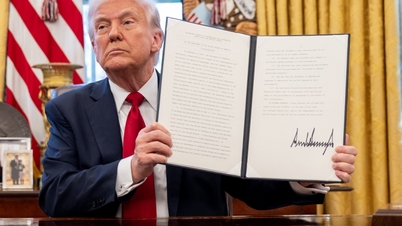 |
| US public debt rises to all-time high. (Source: Getty Images) |
On January 2, the US Treasury Department released a report on the financial situation, including the issue of public debt - a source of tension in Washington. Specifically, the total debt of the federal government exceeded 34 trillion USD. With this debt, each citizen has to "bear" about 100,000 USD and each household nearly 260,000 USD.
Maya MacGuineas, president of the Committee for a Responsible Federal Budget (CRFB), an independent and non-profit financial watchdog, called the record figure “a truly sad ‘achievement’.”
“While our debt levels are dangerous for both our economy and our national security, America cannot afford to stop borrowing,” she said.
Another concern is that the national debt is rising at a time when the economy is relatively strong and unemployment is low, which is considered a good time to rein in the federal deficit.
In June 2023, the Congressional Budget Office estimated that public debt would reach a record high of 181% of US gross domestic product (GDP) by 2053.
The International Monetary Fund (IMF) estimates that China's government debt as of the end of last year was about $14 trillion, less than half of the US public debt. As a percentage of GDP, the US public debt is more than 123%, while China's is only 83%.
"The US public debt is equivalent to the total debt of five countries: China, Japan, UK, France and Italy," experts assessed.
The national debt has skyrocketed in recent years. Republicans say federal spending programs backed by President Joe Biden's administration are too expensive, while Democrats say the GOP-backed tax cuts of 2017 have reduced revenue.
Covid-19 relief packages have also contributed to the debt buildup. The government borrowed heavily under former President Donald Trump and current President Joe Biden to stabilize the economy and aid recovery. But the recovery was accompanied by rising inflation, pushing up interest rates and making it more expensive for the government to service the debt.
White House spokesman Michael Kikukawa said the debt increase was “fueled largely by repeated Republican giveaways to large corporations and the wealthy,” leading to cuts to social security that hurt the American people.
According to ABC News, the national debt level does not seem to be a burden on the US economy because investors are still willing to lend money to the federal government. The loans allow Washington to continue spending on activities without having to raise taxes.
Still, the AP news agency said, the debt path in the coming decades could jeopardize national security and major programs of the world's largest economy. For example, it could affect Social Security and Medicare - which have become the most prominent drivers of government spending forecasts.
America's creditor nations - such as China, Japan, South Korea and European nations - have also cut their holdings of US Treasury bonds.
“Debt will continue to soar in the future, with the US Treasury expected to borrow nearly $1 trillion by the end of March,” said Michael Peterson, CEO of the Peterson Foundation. “Adding trillions of dollars to debt year after year should be a red flag for any policymaker concerned about the future of the world’s largest economy.”
Currently, both Democrats and Republicans are calling for debt reduction. However, neither party has come up with a suitable method to do so.
For example, the Biden administration and Democrats are pushing to raise taxes on the wealthy and corporations to reduce the budget deficit, in addition to funding their domestic agenda.
Meanwhile, Republican lawmakers have called for major cuts to non-defense government programs and the repeal of clean energy tax credits and spending passed in the Deflation Act.
Source



![[Photo] Prime Minister Pham Minh Chinh works with the Standing Committee of Thai Binh Provincial Party Committee](https://vphoto.vietnam.vn/thumb/1200x675/vietnam/resource/IMAGE/2025/5/12/f514ab990c544e05a446f77bba59c7d1)

![[Photo] Prime Minister Pham Minh Chinh receives Swedish Minister of International Development Cooperation and Foreign Trade](https://vphoto.vietnam.vn/thumb/1200x675/vietnam/resource/IMAGE/2025/5/12/ae50d0bb57584fd1bbe1cd77d9ad6d97)

![[Photo] Prime Minister Pham Minh Chinh starts construction of vital highway through Thai Binh and Nam Dinh](https://vphoto.vietnam.vn/thumb/1200x675/vietnam/resource/IMAGE/2025/5/12/52d98584ccea4c8dbf7c7f7484433af5)































































































Comment (0)